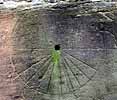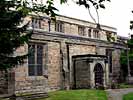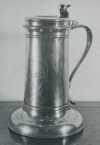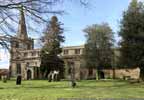For this church:    |
|
 Mass
dial scratched Mass
dial scratchedin the wall |
Inscribed into the stone of the buttress immediately east of the south door of the chancel is a mass-dial, or scratch dial; the gnomon is missing. When made, the south door had two orders of colonettes.
Sometime during the reign of Henry VII, six 3-light clerestory windows were inserted in the wall above the south aisle. At the east end of the aisle there is an aumbry niche similar to the piscina in the chancel.
In 1536, Henry VIII’s ecclesiastical survey showed the rector to have had a house and glebe, with various tithes in kind which amounted to just over £20 a year. In 1542, the advowson passed from the dissolved Lenton Priory to the Archbishop of York – but the annual pension of five shillings went to the King!
In 1553, Edward VI’s Commissioners made an inventory of church goods at Barton. They left a silver chalice and a gold-plated dish for communion purposes; and three bells with a sanctus bell in the steeple – the last would have been rung at the beginning of a Mass.
During the decade after 1630, Archbishop Laud of Canterbury pursued a policy of uniformity of church behaviour and service. He insisted that the fabric be kept in good order; that the Holy Table be crossways at the east end of the chancel; that there be altar rails; and that the Canons of 1603 re furnishings and ornaments be obeyed. Barton church is recorded as spending £18 6s 8d between 1635 and 1639 as a result of his efforts.
As the disagreements with King Charles I intensified, Parliament required all males over 18 to swear an oath of support for the Protestant religion. In Barton in 1641, there were no refusals; 82 names are recorded including Barnaby Barlowe, Parson.
An inquisition of 1650 during the period of the Commonwealth, held in Nottingham, declared that the annual value of Barton Rectory was £120 'under sequestration for the delinquency of Barnaby Barlowe', the rector who presumably did not support the Parliamentary cause. The replacement, dated 1657, was Jonathan Goodwin who was considered to be 'well affected to the present Government.' He later recanted and was officially installed as incumbent under the restored monarchy of Charles II in 1662.
In 1676 when Rector Coadworth held the benefice, there were 80 communicants in Barton village and no papists or dissenters.
A glebe terrier for 1686 indicates a rectory holding of a little more than 41 acres.
 The
south side The
south sideshowing the porch |
About 1693, the south porch was added, described by Stretton as 'of the Doric order, badly appropriate to the church'.
The Parish Register records a flood in July 1736:
'It began to rain on Fryday the second Day of July 1736 about six in the Evening, and continued raining incessantly till Monday following, about eight or nine in the morning. When the Trent swell’d to that Degree, that about five a clock the same evening, The Water was twelve or thirteen Inches deep, all over the Church Floor; Which is the more remarkable because the Water was never known to rise up to the Walls of the Church, in the memory of the oldest Person now alive. July ye 17th 1736. Jos. Milner, Rector.'
Archbishop Herring’s Visitation in 1743 shows 31 families in the village, including one Quaker widow and her son; there were usually 20-30 communicants, sometimes 40.
 Photo
of 17th Photo
of 17thCentury flagon, sold in 1951 |
Another terrier for 1764, written after the 1759 Act of Parliament [enclosure of the village lands] reveals that as a result the glebe was now just over 215 acres. A curious note records five shillings as a fee farm rent to the Duke of Leeds. Maybe this began as the Prior of Lenton’s pension(?) There were three bells and a clock; a pewter flagon – possibly that which was inscribed “This is my bloud” and sold in 1951 (of which there is a photograph in the church) – 2 pewter plates, a small silver cup; and a cloth and napkin for the communion table.
A terrier with no date, but likely to be at the turn of the eighteenth and nineteenth centuries, adds a silver salver inscribed 'Barton Church 1735'; William Harding was the curate, with Churchwardens Wright and Redfern.
A seat plan for June 1806 has some villagers’ names as well as the Revd Jn Storer and Churchwardens, Wright and Wallis.
A modernisation was effected around 1810. The church was paved throughout with Yorkshire stone resulting in the loss of some old gravemarkers (with Calvary crosses and border inscriptions) in the floor. At this time, the rood loft (rather like that still present at Strelley) was removed; only the mutilated cancelli remain in what is now the screen. High in the wall to the south of the screen, the former arched doorway which gave access to the rood loft is discernible.
The Royal Coat of Arms, possibly of William IV, were once mounted above the door to the tower. This is no longer there but several nails in the wall suggest a former presence.
There is another terrier for 1840, content similar to the previous one.
During the mid-19th century, the Revd Fitzgerald Wintour kept a diary with brief factual entries. He was Rector from 1829 till his death in 1863. He wrote about the congregation, usually between 70 and 90, exceptionally more, eg 118 in October 1843. There are sparse details of his social and family life, mixing with the local gentry; details of his other flock members are very rare; comprehensive information is given about glebe farm affairs, the weather; and his shooting/fishing activity, eg: “1842, shot on farm 87 hares, 336 rabbits, 21 birds, 7 pheasants, 1 landrail and 1 cat”.
The chancel was restored in 1866-7 by G. E. Street. In 1877 the church was partially restored and nine years later it was 'fully restored'. Both restorations were possibly supervised by Nottingham architect, T. C. Hine.
At some point the spire was damaged by lightning – it is known to have been repaired in 1893.
At once stage there must have been a church well. It is mentioned by Firth in 1916.
A restoration took place in 1931 to 1934. There were repairs to the nave roof and parapet executed by C M Oldrid Scott, architect, and Thomas Long, builder, at a cost of £725.
The south aisle roof was repaired in 1975 because of death watch beetle infestation at a cost of £3,300.
Repairs to the chancel and sanctuary floors in 1984 occasioned the re-siting of the alabaster Sacheverell tomb away from contact with north and east walls.
In the late twentieth century there was a problem with damp coming up through the floor. The stone floor in the nave was raised in 1997, a membrane inserted, and the floor tiles put back. This involved temporarily lifting the organ too.
Significant modernization took place in 2004. Gas-fired central heating was installed, the church rewired and a water supply brought in.
Further alterations took place in 2007. A new metal porch door was installed and the wooden floor underneath the pews was replaced, including lowering it to the level of the rest of the nave.
Early in 2008 a large proportion of the lead covering of the roof was stolen. The PCC decided to replace the whole of the main roof with a stainless steel covering in order to avoid further thefts. It also has the advantage that it reduced the weight on the roof structure by several tons. The work was completed before Christmas 2008.
The present congregation is about 20.






